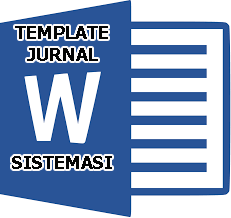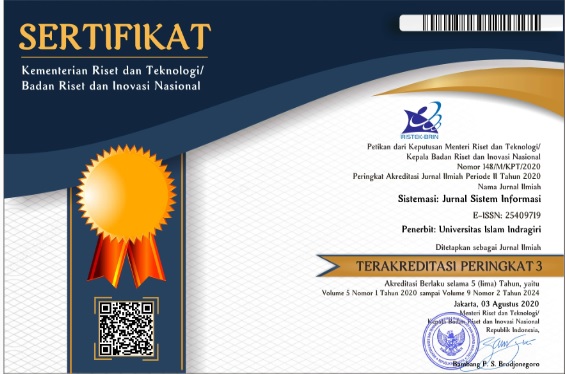Lung Cancer Classification Using the Extreme Gradient Boosting (XGBoost) Algorithm and Mutual Information for Feature Selection
Abstract
Keywords
Full Text:
PDFReferences
R. D. Marzuq, S. A. Wicaksono, and N. Y. Setiawan, “Prediksi Kanker Paru-Paru menggunakan Algoritme Random Forest Decision Tree,” J. Pengemb. Teknol. Inf. dan Ilmu Komput., Vol. 7, No. 7, pp. 3448–3456, 2023.
J. Al-Tawalbeh, B. Alshargawi, H. Alquran, W. Al-Azzawi, W. A. Mustafa, and A. Alkhayyat, “Classification of Lung Cancer by Using Machine Learning Algorithms,” IICETA 2022 - 5th Int. Conf. Eng. Technol. its Appl., pp. 528–531, 2022, doi: 10.1109/IICETA54559.2022.9888332.
R. Bisht, N. Thapliyal, R. Bisht, and G. Wadhwa, “Lung Cancer Detection using Ensemble Learning and Machine Learning Algorithms,” 2nd Int. Conf. Artif. Intell. Mach. Learn. Appl. Healthc. Internet Things, AIMLA 2024, pp. 1–6, 2024, doi: 10.1109/AIMLA59606.2024.10531596.
S. Bharathy, R. Pavithra, and B. Akshaya, “Lung Cancer Detection using Machine Learning,” Proc. - Int. Conf. Appl. Artif. Intell. Comput. ICAAIC 2022, No. Icaaic, pp. 539–543, 2022, doi: 10.1109/ICAAIC53929.2022.9793061.
A. Rahmadeyan and M. Mustakim, “Seleksi Fitur pada Supervised Learning: Klasifikasi Prestasi Belajar Mahasiswa Saat dan Pasca Pandemi COVID-19,” J. Nas. Teknol. dan Sist. Inf., Vol. 9, No. 1, pp. 21–32, 2023, doi: 10.25077/teknosi.v9i1.2023.21-32.
H. I. H. Yusri, A. A. Ab Rahim, S. L. M. Hassan, I. S. A. Halim, and N. E. Abdullah, “Water Quality Classification using SVM And XGBoost Method,” 2022 IEEE 13th Control Syst. Grad. Res. Colloquium, ICSGRC 2022 - Conf. Proc., No. July, pp. 231–236, 2022, doi: 10.1109/ICSGRC55096.2022.9845143.
T. Gori, A. Sunyoto, and H. Al Fatta, “Preprocessing Data dan Klasifikasi untuk Prediksi Kinerja Akademik Siswa,” J. Teknol. Inf. dan Ilmu Komput., Vol. 11, No. 1, pp. 215–224, 2024, doi: 10.25126/jtiik.20241118074.
S. Gadge and A. Karande, “Study of Different Types of Evaluation Methods in Classification and Regression,” 2022 IEEE Reg. 10 Symp. TENSYMP 2022, pp. 1–5, 2022, doi: 10.1109/TENSYMP54529.2022.9864426.
I. W. Dharmana, I. G. A. Gunadi, and L. J. E. Dewi, “Deteksi Transaksi Fraud Kartu Kredit menggunakan Oversampling ADASYN dan Seleksi Fitur SVM-RFECV,” J. Teknol. Inf. dan Ilmu Komput., Vol. 11, No. 1, pp. 125–134, 2024, doi: 10.25126/jtiik.20241117640.
W. Mostert and K. M. Malan, “Comparative Analysis,” pp. 1–16, 2021.
B. Yao, C. Li, and Y. Chen, “Supervised Feature Selection based on Sparse Representation and Mutual Information,” Proc. 2023 IEEE 5th Int. Conf. Civ. Aviat. Saf. Inf. Technol. ICCASIT 2023, pp. 1354–1358, 2023, doi: 10.1109/ICCASIT58768.2023.10351667.
A. Nageswari, U. Jyothi, G. Divya, T. Ammannamma, and V. Usha, “Water Quality Classification using XGBoost method,” ICCCMLA 2024 - 6th Int. Conf. Cybern. Cogn. Mach. Learn. Appl., pp. 302–306, 2024, doi: 10.1109/ICCCMLA63077.2024.10871422.
V. S. Desdhanty and Z. Rustam, “Liver Cancer Classification using Random Forest and Extreme Gradient Boosting (XGBoost) with Genetic Algorithm as Feature Selection,” 2021 Int. Conf. Decis. Aid SCI. Appl. DASA 2021, pp. 716–719, 2021, doi: 10.1109/DASA53625.2021.9682311.
V. Jagadeesh and P. Sivakumar, “Enhanced Pipeline Safety: Cloud-based Leak Prediction Using XGBoost,” Proc. - 2024 IEEE 16th Int. Conf. Commun. Syst. Netw. Technol. CICN 2024, pp. 1087–1091, 2024, doi: 10.1109/CICN63059.2024.10847573.
E. Helmud, E. Helmud, F. Fitriyani, and P. Romadiana, “Classification Comparison Performance of Supervised Machine Learning Random Forest and Decision Tree Algorithms using Confusion Matrix,” J. Sisfokom (Sistem Inf. dan Komputer), Vol. 13, No. 1, pp. 92–97, 2024, doi: 10.32736/sisfokom.v13i1.1985.
R. Prasetya, “Data Mining Application on Weather Prediction using Classification Tree, Naïve Bayes and K-Nearest Neighbor Algorithm with Model Testing of Supervised Learning Probabilistic Brier Score, Confusion Matrix and ROC,” Jaict, Vol. 4, No. 2, p. 25, 2020, doi: 10.32497/jaict.v4i2.1690.
I. K. Nti, O. Nyarko-Boateng, and J. Aning, “Performance of Machine Learning Algorithms with Different K Values in K-fold CrossValidation,” Int. J. Inf. Technol. Comput. Sci., Vol. 13, No. 6, pp. 61–71, 2021, doi: 10.5815/ijitcs.2021.06.05.
N. C. Ramadhan, H. H. H, T. Rohana, and A. M. Siregar, “Optimasi Algoritma Machine Learning menggunakan Seleksi Fitur Xgboost untuk Klasifikasi Kanker Payudara,” TIN Terap. Inform. Nusant., Vol. 5, No. 2, pp. 162–171, 2024, doi: 10.47065/tin.v5i2.5408.
C. Giola, P. Danti, and S. Magnani, “Learning Curves: A Novel Approach for Robustness Improvement of Load Forecasting †,” Eng. Proc., Vol. 5, No. 1, 2021, doi: 10.3390/engproc2021005038.
DOI: https://doi.org/10.32520/stmsi.v14i5.5345
Article Metrics
Abstract view : 927 timesPDF - 265 times
Refbacks
- There are currently no refbacks.

This work is licensed under a Creative Commons Attribution-ShareAlike 4.0 International License.









